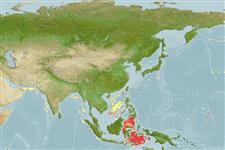>
Lophiiformes (Anglerfishes) >
Oneirodidae (Dreamers)
Etymology: Oneirodes: Greek, 'oneiros' = a dream or dreamlike or out of a dream (suggesting this fish is so strange and marvelous that can exist only in dreams) (Ref. 86949).
Eponymy: Dr Ernst Johannes Schmidt (1877–1933) was a Danish biologist who became the Director of the Laboratoire Carlsberg (1909–1933). [...] (Ref. 128868), visit book page.
More on authors: Regan & Trewavas.
Environment: milieu / climate zone / depth range / distribution range
Ecologie
marien bathypelagisch; diepte ? - 2500 m (Ref. 40966). Deep-water
Indo-West Pacific.
Grootte / Gewicht / Leeftijd
Maturity: Lm ? range ? - ? cm
Max length : 9.2 cm SL mannelijk / geslacht onbekend; (Ref. 26783)
Korte beschrijving
Determinatiesleutels | Morfologie | Morfometrie
Dorsale zachte stralen (totaal) : 5 - 6; Anale zachte stralen: 4. Characterized by having escal morphology: esca with large complex anterior appendage consisting of a wide compressed base bearing a relatively short unpaired branched filament on posterior margin, 2 extremely long distal filaments that bifurcate as many as five times, and a stout, bifurcated medial filament, each branch becomes highly branched distally; pair of filamentous, highly branched medial escal appendages less than length of escal bulb; terminal escal papilla with a single distal streak of pigment; slender unbranched posterior escal appendage less than length of escal bulb; relatively short, filamentous, branched anterolateral appendage on each side; long and narrow subopercle, dorsal end tapering, rounded or pointed distally, without indentation on posterodorsal margin; length of ventral fork of opercle 26.6-27.7% SL; ratio of lengths of the dorsal and ventral forks of opercle 0.47-0.51; absence of epibranchial teeth; presence of teeth on pharyngobranchial II; upper jaw teeth 60-67, lower jaw teeth 56-76; teeth on vomer 5-6; dorsal fin rays 5-6; anal fin rays 4; pectoral fin rays 15-17; head length 43.8-47.7% SL; head depth 42.4-50.0% SL; premaxilla length 35.9-40.0% SL; length of lower jaw 50.0-52.7% SL; length of illicium 37.5-107.7% SL (Ref. 86949).
Levenscyclus en paargedrag
Maturiteit | Voortplanting | Paaien | Eieren | Fecunditeit | Larven
Pietsch, T.W., 1999. Oneirodidae. Dreamers (deep-sea anglerfishes). p. 2031-2032. In K.E. Carpenter and V.H. Niem (eds.) FAO species identification guide for fishery purposes. The living marine resources of the WCP. Vol. 3. Batoid fishes, chimaeras and bony fishes part 1 (Elopidae to Linophrynidae). FAO, Rome. (Ref. 12940)
Status op de Rode Lijst van het IUCN (Ref. 130435: Version 2024-2)
Gevaar voor de mens
Harmless
Gebruik door de mens
Tools
Speciale rapporten
Download XML
Internetbronnen
Estimates based on models
Preferred temperature (Ref.
123201): 2.4 - 3.6, mean 3.1 °C (based on 458 cells).
Fylogenetische diversiteitsindex (Ref.
82804): PD
50 = 0.5000 [Uniqueness, from 0.5 = low to 2.0 = high].
Bayesian length-weight: a=0.01995 (0.00906 - 0.04395), b=3.01 (2.83 - 3.19), in cm total length, based on all LWR estimates for this body shape (Ref.
93245).
Trofisch niveau (Ref.
69278): 3.9 ±0.7 se; based on size and trophs of closest relatives
Weerstandsvermogen (Ref.
120179): Hoog, minimale populatieverdubbelingstijd minder dan 15 maanden (Preliminary K or Fecundity.).
Fishing Vulnerability (Ref.
59153): Low vulnerability (10 of 100).
